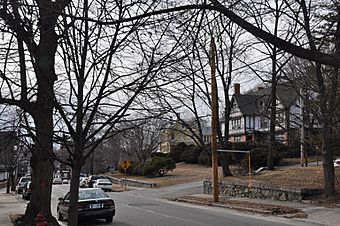Pleasant–High Historic District facts for kids
Quick facts for kids |
|
|
Pleasant–High Historic District
|
|

Pleasant Street
|
|
| Location | Methuen, Massachusetts |
|---|---|
| Architectural style | Late Victorian |
| MPS | Methuen MRA |
| NRHP reference No. | 84002417 |
| Added to NRHP | June 20, 1984 |
The Pleasant–High Historic District is a special area in Methuen, Massachusetts. It's where some of the oldest homes in the town are located. These homes are found along High and Pleasant Streets, and a few nearby streets. This district is important because it shows how Methuen grew from a farming town into a more developed place. It was added to the National Register of Historic Places in 1984, which means it's recognized as a historic treasure. This district is right next to the Spicket Falls Historic District.
Contents
Exploring Methuen's Oldest Neighborhood
The Pleasant–High Historic District holds many clues about Methuen's past. It shows how people lived and built their homes long ago. This area was one of the first places in Methuen where people built houses, not just farms.
How Methuen Began
Before the 1800s, Methuen was mostly a farming town. It even included parts of what is now Lawrence. The town's main industries were a gristmill (for grinding grain) and a cotton mill. These mills were located near the Spicket River falls, in the center of town.
In 1806, a new road called the Turnpike was built. Today, this road is known as Broadway. Building this road helped new homes appear to its east. These houses were on a small hill, looking over the mills and the river. By 1810, Pleasant Street and High Street were created. High Street was first called George Street. Soon after, the first homes in the Federal style were built. These include the house at 36 High Street (around 1820) and 18-20 Pleasant Street (around 1810).
Homes and Architecture Over Time
The mills in Methuen grew bigger in 1826 and again in 1855. This growth meant more people came to work in the mills. So, more houses were needed for these workers. The First Congregational Church was built at 30 Pleasant Street in 1832. This made the area even more important as the town's main center.
After 1855, many homes in the Second Empire style were built. You can also find examples of other 19th-century house styles. In 1890, a mill owner named David Nevins planned a new neighborhood. It had about 100 building lots near Gage and Stevens Streets. Many homes from this time still stand today. They were built between 1890 and 1910. These houses show styles like Queen Anne, Shingle, Georgian Revival, and Colonial Revival.
A Special Public Space
The most important public spot in the district is the American Civil War memorial. It is located in a triangular area. This is where Pleasant Street and Charles Street meet. It's a place where people can remember important history.



